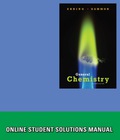
Concept explainers
A mixture contained zinc sulfide, ZnS, and lead sulfide, PbS. A sample of the mixture weighing 6.12 g was reacted with an excess of hydrochloric acid. The reactions are
If the sample reacted completely and produced 1.049 L of hydrogen sulfide, H2S, at 23°C and 762 mmHg, what were the percentages of ZnS and PbS in the mixture?
Trending nowThis is a popular solution!

Chapter 5 Solutions
Student Solutions Manual for Ebbing/Gammon's General Chemistry
Additional Science Textbook Solutions
Biology: Life on Earth (11th Edition)
Brock Biology of Microorganisms (15th Edition)
General, Organic, and Biological Chemistry - 4th edition
Fundamentals Of Thermodynamics
Human Anatomy & Physiology (2nd Edition)
- this is an inorganic chemistry question please answer accordindly!! its just one question with parts till (n) JUST ONE QUESTION with its parts spread out in the form of different images attached 2 IMAGES ATTACHED PLEASE SEE BOTH, please answer EACH part till the end and dont just provide wordy explanations wherever asked for structures, graphs or diagrams, please DRAW DRAW them on a paper and post clearly!! answer the full question with all details as needed EACH PART CLEARLY please or let another expert handle it thanks!! im reposting this please solve all parts and drawit not just word explanations!!arrow_forwardShow work. don't give Ai generated solutionarrow_forwardthis is an inorganic chemistry question please answer accordindly!! its just one question with parts till (g) JUST ONE QUESTION with its parts spread out in the form of different images attached 2 IMAGES ATTACHED PLEASE SEE ALL, please answer EACH part till the end and dont just provide wordy explanations wherever asked for structures or diagrams, please DRAW DRAW them on a paper and post clearly!! answer the full question with all details EACH PART CLEARLY please thanks!! im reposting this please solve all parts and drawit not just word explanations!!arrow_forward
- The complex anion in Ba₂[Cr(CN)6] is a tetragonally distorted octahedral complex (Dan). Baz[Cr(CN)6] is paramagnetic at room temperature with S = 1. Assume that the complex is a low-spin complex. a) Identify if the [Cr(CN)6] anionic complex has 4 long and 2 short bonds (left side of figure) or if the complex has 4 short and 2 long bonds (right side of figure) with respect to Oh symmetry. Use crystal field theory to answer this question. Explain/rationalize your decision. Can the provided information decide on the order of orbital energies? Dah Tetragonal Distortion ய Dab z-compression z-elongation x and y elongation O symmetry x and y compression E eg d² dx²-y² t2g dxy dxz dyz Question 4 a) continued: Provide your explanations in the space below. b) At low temperatures Ba₂[Cr(CN)6] is ferromagnetically ordered with a phase transition to a paramagnetic phase at Tc = 150K. Sketch the magnetic susceptibility vs. temperature in the diagram below. Indicate Tc as well as the paramagnetic and…arrow_forwarda) Draw the octahedral mer-[FeCl3(CN)3] complex and determine its point group. Use proper wedges and dashes in order to illustrate 3 dimensional details. Use the point group to determine if the complex has a resulting net dipole moment and describe its allowed direction with respect to its symmetry elements (if applicable). ード M 4- b) Substitute one chlorido ligand in mer-[FeCl3(CN)3] 4 with one fluorido ligand. Determine all possible isomers and their corresponding point groups. Use the point groups to determine if the complexes have resulting net dipole moments and describe their allowed direction with respect to its symmetry elements (if applicable). The number of complex sketches below is not necessarily indicative of the number of isomers. 4- 4- ☐☐☐ c) Substitute two chlorido ligands in mer-[FeCl3 (CN)3] 4 with two fluorido ligands. Determine all possible isomers and their corresponding point groups.. Use the point groups to determine if the complexes have resulting net dipole…arrow_forwardShow work. don't give Ai generated solutionarrow_forward
- Differentiate electron spin and electron spin moment.arrow_forwardDifferentiate between nuclear spin and electron spin.arrow_forwardDraw the trigonal prismatic MH6 molecular compound, where M is a 3d transition metal. a) Draw the trigonal prismatic MH6 molecular compound and determine its point group. b) i. What is the symmetry species for the 4s orbital on the central metal? ii. What is the symmetry species for the 3dx²-y² orbital on the central metal? Note: The z-axis is the principal axis. iii. Suggest a crystal field energy diagram for a d² electron configuration in a trigonal prismatic coordination environment. Label the metal d-orbital with their corresponding symmetry species label. Use the appropriate character table in the resource section.arrow_forward
 Chemistry: The Molecular ScienceChemistryISBN:9781285199047Author:John W. Moore, Conrad L. StanitskiPublisher:Cengage Learning
Chemistry: The Molecular ScienceChemistryISBN:9781285199047Author:John W. Moore, Conrad L. StanitskiPublisher:Cengage Learning Chemistry: Principles and PracticeChemistryISBN:9780534420123Author:Daniel L. Reger, Scott R. Goode, David W. Ball, Edward MercerPublisher:Cengage Learning
Chemistry: Principles and PracticeChemistryISBN:9780534420123Author:Daniel L. Reger, Scott R. Goode, David W. Ball, Edward MercerPublisher:Cengage Learning Chemistry & Chemical ReactivityChemistryISBN:9781337399074Author:John C. Kotz, Paul M. Treichel, John Townsend, David TreichelPublisher:Cengage Learning
Chemistry & Chemical ReactivityChemistryISBN:9781337399074Author:John C. Kotz, Paul M. Treichel, John Townsend, David TreichelPublisher:Cengage Learning Chemistry & Chemical ReactivityChemistryISBN:9781133949640Author:John C. Kotz, Paul M. Treichel, John Townsend, David TreichelPublisher:Cengage Learning
Chemistry & Chemical ReactivityChemistryISBN:9781133949640Author:John C. Kotz, Paul M. Treichel, John Townsend, David TreichelPublisher:Cengage Learning General Chemistry - Standalone book (MindTap Cour...ChemistryISBN:9781305580343Author:Steven D. Gammon, Ebbing, Darrell Ebbing, Steven D., Darrell; Gammon, Darrell Ebbing; Steven D. Gammon, Darrell D.; Gammon, Ebbing; Steven D. Gammon; DarrellPublisher:Cengage Learning
General Chemistry - Standalone book (MindTap Cour...ChemistryISBN:9781305580343Author:Steven D. Gammon, Ebbing, Darrell Ebbing, Steven D., Darrell; Gammon, Darrell Ebbing; Steven D. Gammon, Darrell D.; Gammon, Ebbing; Steven D. Gammon; DarrellPublisher:Cengage Learning Chemistry for Engineering StudentsChemistryISBN:9781337398909Author:Lawrence S. Brown, Tom HolmePublisher:Cengage Learning
Chemistry for Engineering StudentsChemistryISBN:9781337398909Author:Lawrence S. Brown, Tom HolmePublisher:Cengage Learning





